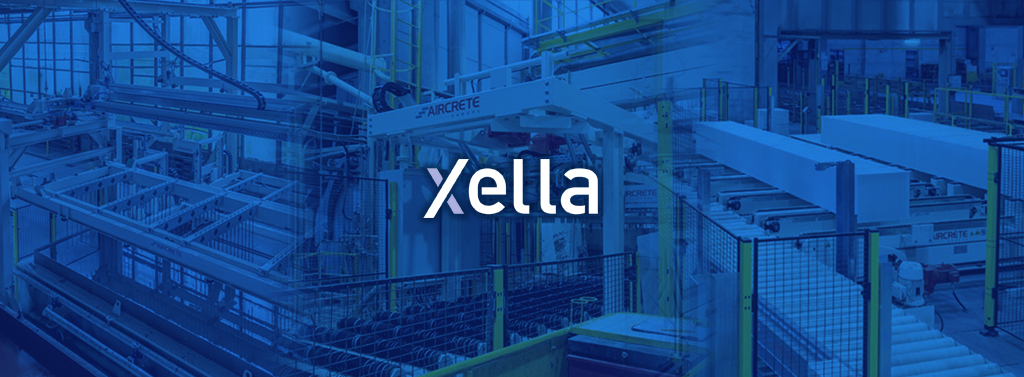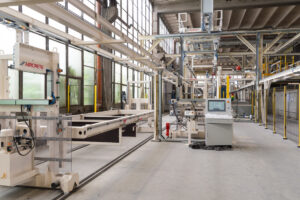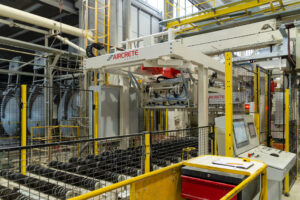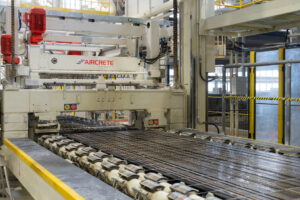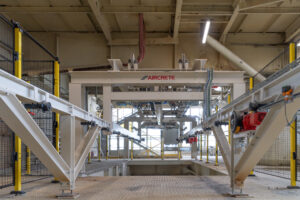From September 2023, large-size Ytong panels with a super-smooth surface are being produced in Ostrołeka, Poland. The investment of Xella Group in a new installation is a joint undertaking of the building materials manufacturer and Aircrete Europe, a global leader in providing machinery and technology for AAC production facilities.
The Polish construction market is changing rapidly. About fifteen years ago, the ratio of labor costs to materials in a building project was roughly 20% to 80%; today it is fifty-fifty. We are approaching the EU average, where labor accounts for as much as 70% of investment costs.
“Investors are increasingly opting for construction technologies that, even if more expensive than others, make it possible to reduce labor costs significantly, as they require fewer workers and man-hours. Xella Polska is meeting these expectations. For several years, we have been strongly developing our Effective Building strategy, offering, as the only manufacturer of aerated concrete in Poland, a whole range of large-size products. Large elements combined with mechanization of work allow you not only to reduce the number of workers on site, but also to shorten the time of wall construction, which is much appreciated by general contractors and developers,” says Robert Turski, CEO of Xella Polska.
Large size – solving the problem of labor shortage
This approach also addresses the persistent problem of the Polish labor market: the shortage of workers. Poland has one of the lowest unemployment rates in the European Union, and despite the huge influx of war refugees from Ukraine, there is a chronic shortage of hands, especially in the construction industry.
As Turski explains, “The future of construction in Poland is prefabrication plus large-size wall, floor and roof elements. With this in mind, we are constantly expanding our offer in this segment. And despite the current economic situation, high inflation and difficulties with obtaining investment loans, we enjoy a steady increase in sales of our large-size systems. For this reason, we’ve decided to start production of two types of Ytong panels in Poland. So far, we have imported Ytong Panel for partition walls and Ytong Panel SWE for structural walls from Xella’s plants in Germany. Producing them locally will allow us to lower the price and increase the competitiveness of our solutions for fast and effective construction.”
Panel reinforcement section
Investment in the oldest Ytong plant in Poland
The production of Ytong panels was launched in Ostrołeka, at Xella’s first and longest-operating plant in Poland. Privatized and modernized in 1995, it started to turn out the first Ytong blocks as early as in April 1996. The plant has repeatedly won the International AAC Quality Competition attended by the Ytong plants from all branches of Xella Group.
“I think that our plant was chosen on account of its team’s wide experience and high quality of our blocks,” says Ostrołeka manager Jarosław Joka. Another factor, as he explains, was the extensive facilities, making it very easy to accommodate a new production line. “We have plenty of space, which only needed to be adapted for panel production.”
Coating the rebars with anti-corrosion paint
The workers joke that panel production marks a return to tradition. In the 1970s and 1980s, when the plant operated as the state-owned Prefabet, it produced reinforced AAC panels. “The new panel reinforcement line has been located in the same hall where wall elements were once reinforced, so we are taking advantage of the existing layout of the plant,” says Joka.
Krzysztof Siarkiewicz, project manager and regional production director of Xella Polska, talks about the diffculties to overcome when devising a new production line for an already working plant. “In terms of design, engineering and logistics, it’s quite a challenge to add a new installation to a functioning plant, combining it with the existing line and its safety and communication systems. It’s definitely a much more demanding task than building a new line from scratch. All the more so as the panel production line requires entirely new installations only at the initial and final stages, that is reinforcing and packaging, respectively. The middle stage utilizes the already existing line, although a few elements had to be modified, notably the cutting line,” says Director Siarkiewicz.
Modernization of the existing cutting line
Preparing for the project
At the preliminary design stage, the Xella team realized that the existing cutter was not suitable for the production of long elements with super smooth surfaces. And it was the need to modernize this device that led to choosing the partner for the entire project. A major advantage of elements with a super smooth surface is the minimum finishing requirements once installed, thereby reducing materials and labor, making the installation cheaper and faster.
“We cooperated with the Dutch company Stork, the predecessor of today’s Aircrete Europe team, 20 years ago when a cutting line had to be installed at the Ostrołeka plant. Their device still works flawlessly. For this reason, we sent an inquiry to Aircrete not only for the modernization of this particular section, but also for the design of the entire line. Eventually, we opted for their bid because of its comprehensive approach, their massive experience and advanced technologies of AAC production.” says Tomasz Wisniewski CTO Xella Polska, sponsor of the project.
Storage area
But first the Ostrołeka plant had to be adapted to the requirements of the new line. “Within a year, we had to prepare the plant for the new technology. This called for some technological modifications, dismantling and construction work. For example, we extended the packing room area to accommodate the new packaging line. To that end, we moved one wall by 24 meters and added the three missing ones; fortunately, there was a covered storage area on its other side so the roof had already been provided. We also knew that panel production would involve upgrading the molds to support the new frames with reinforcement. This entailed further changes, because the mold with the frame is higher than the existing one and it would not fit through the old gates leading to the pre-curing chambers. So, we had to enlarge all the openings and change entirely how the chambers are closed,” explains the plant manager.
Finally, on March 1, 2023, production at the plant was temporarily stopped and the installation of the new AAC panel production line began. Aircrete engineers supervised the assembly work, which was mainly carried out by the Ostrołeka team, supported by subcontractors. By mid-April, virtually the entire line – machinery, equipment, the so-called hardware – was in its place. Since then, there has been extensive programming, !ne-tuning and testing the equipment.
New packaging line
Panel reinforcement section
A brand new line for reinforcement preparation has been set up in Ostrołęka with three stations where workers will manually prepare reinforcements on a mobile frame suspended from a special frame.
The reinforced frame then goes through fully automatic processes with restricted worker access for safety reasons. These include coating the rebars with anti-corrosion paint. The finished frame goes upstairs to the so-called parking lot, where it dries. After a while, it can be moved for further production or waits for the right moment, when it is needed for the production of a particular range of panels. From there, the frame is transported to the existing casting line, located on the lower level, and then, after filling the mold with the mixture, the frame with the prepared reinforcement is placed on the mold. This then moves to the pre-curing chamber. Once the pre-curing process is complete, the mold with the frame goes to the cutter. Just before cutting, the frame is separated and pulled out of the mold so that the reinforcement remains in the hardening aerated concrete.
The reinforcement section is also used to clean the frames as they return after removal from the mixture. Each time the frame, along with the pins for mounting the reinforcement, must be cleaned of AAC residue. Then it goes into a bath with special paraffin, which makes the pins repel anti-corrosion paint and prevents the AAC mixture from sticking to the pins. A clean and pre-prepared frame is transported to a storage area, the so-called buffer, where it waits for a decision to be reinforced or moves immediately to the reinforcement station.
Modernization of the existing cutting line
A major challenge of this project was to modify the cutting line. As the plant manager points out, upgrading it meant replacing the core of the system. ‘Earlier, we had a single-section cutter. The AAC mass was placed still while the cutting wire section moved alongside and cut it. Now the working principle is a bit different: the cutting wire section is anchored while the mass is pushed through it. The previous cutting wire section was structurally unfit for the high frequency of vibration that can be now applied to the cutting wires, using the Aircrete High-Speed-Cutting- Frame (HSCF). Precise dimensions and smoothness of the panel surface are crucial parameters for us. The modernized device has double wires, one for the actual cutting, the other for smoothing, which allows us to obtain the desired smooth surface. The cutter works very well and has met all our expectations,” says Joka.
Director Siarkiewicz also appreciates how easy it is now to maintain cleanliness. ‘Previously, the cutting wire traveled the entire length of the mass and the overgrowth was knocked off along this section. Now everything drops in one place, where the cutting is done. This makes it easier to remove the overgrowth and keep this section of the plant clean.’
New packaging line
The next production stage – autoclaving aerated concrete – is carried out on the existing line. Another crucial part of the project is an entirely new packaging line. The process of packing panels could not be performed at the station that handles small Ytong blocks. Here, too, Aircrete is the main technology supplier and integrator.
“While our colleagues at other Xella’s plants pack Ytong panels on pallets, we decided to try another solution: packing on wooden beams. Aircrete had this type of packaging in its offer. The equipment for feeding the beams and shrink-wrapping the packages with panels, to be integrated with the production line, was supplied by OMS.” says the plant manager.
Impressions of the ceremonial opening of the upgraded Ostrołeka plant
Technological revolution in AAC production in Poland
The ceremonial opening of the new production line took place on 21 September 2023. The event was attended by representatives of the Management Board Xella Group and Xella Polska, the Starost of Ostrołeka Stanisław Kubeł and employees of Xella Polska.
The new line produces a wide range of AAC products of two systems for fast wall construction: Ytong Panel for partition walls and Ytong Panel SWE for structural walls. The latter system also has an additional variation: Ytong Panel SWE Ultra+, which enables the construction of single-layer walls. The new line is fully integrated into existing production so that, for example, one shift can produce panels and another shift can produce small-size Ytong blocks.
“We see the current line as the !rst, base stage of the project. If sales of Ytong Panel and Ytong Panel SWE grow fast, we plan a second stage, allowing us to increase the production capacity of the plant” says Siarkiewicz.
As CEO Turski concludes, “This is no ordinary launch of another new variety of AAC blocks. This is a technological revolution that takes Xella Polska’s production to a higher level. We are becoming a virtually unrivaled supplier of large-size AAC panels in Poland. And despite the economic hardships in the country and Europe, this major undertaking allows us to look to the future with greater optimism.”

